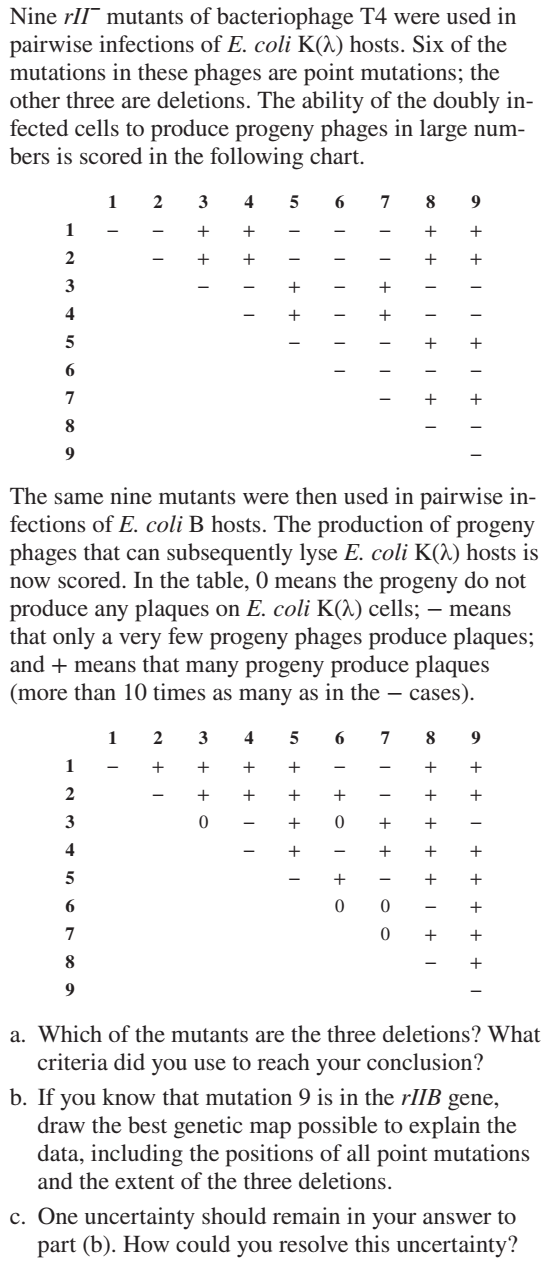Nine rII mutants of bacteriophage T4 were used in pairwise infections of E. coli K(^) hosts. Six of the mutations in these phages are point mutations; the other three are deletions. The ability of the doubly in- fected cells to produce progeny phages in large num- bers is scored in the following chart. 2 3 4 5 6. 3 4 6. The same nine mutants were then used in pairwise in- fections of E. coli B hosts. The production of progeny phages that can subsequently lyse E. coli K(1) hosts is now scored. In the table, 0 means the progeny do not produce any plaques on E. coli K(^) cells; – means that only a very few progeny phages produce plaques; and + means that many progeny produce plaques (more than 10 times as many as in the – cases). 3 4 6. 8. 3 4 6. a. Which of the mutants are the three deletions? What criteria did you use to reach your conclusion? b. If you know that mutation 9 is in the rIIB gene, draw the best genetic map possible to explain the data, including the positions of all point mutations and the extent of the three deletions. c. One uncertainty should remain in your answer to part (b). How could you resolve this uncertainty? + + + +
Nine rII mutants of bacteriophage T4 were used in pairwise infections of E. coli K(^) hosts. Six of the mutations in these phages are point mutations; the other three are deletions. The ability of the doubly in- fected cells to produce progeny phages in large num- bers is scored in the following chart. 2 3 4 5 6. 3 4 6. The same nine mutants were then used in pairwise in- fections of E. coli B hosts. The production of progeny phages that can subsequently lyse E. coli K(1) hosts is now scored. In the table, 0 means the progeny do not produce any plaques on E. coli K(^) cells; – means that only a very few progeny phages produce plaques; and + means that many progeny produce plaques (more than 10 times as many as in the – cases). 3 4 6. 8. 3 4 6. a. Which of the mutants are the three deletions? What criteria did you use to reach your conclusion? b. If you know that mutation 9 is in the rIIB gene, draw the best genetic map possible to explain the data, including the positions of all point mutations and the extent of the three deletions. c. One uncertainty should remain in your answer to part (b). How could you resolve this uncertainty? + + + +
Biology: The Dynamic Science (MindTap Course List)
4th Edition
ISBN:9781305389892
Author:Peter J. Russell, Paul E. Hertz, Beverly McMillan
Publisher:Peter J. Russell, Paul E. Hertz, Beverly McMillan
Chapter17: Bacterial And Viral Genetics
Section: Chapter Questions
Problem 1ITD
Related questions
Question
100%
This is question 34, chapter 7, Hartwell Glenetics 6th textbook. I do not know how to answer parts b and c

Transcribed Image Text:Nine rII mutants of bacteriophage T4 were used in
pairwise infections of E. coli K(^) hosts. Six of the
mutations in these phages are point mutations; the
other three are deletions. The ability of the doubly in-
fected cells to produce progeny phages in large num-
bers is scored in the following chart.
2
3
4
5
6.
3
4
6.
The same nine mutants were then used in pairwise in-
fections of E. coli B hosts. The production of progeny
phages that can subsequently lyse E. coli K(1) hosts is
now scored. In the table, 0 means the progeny do not
produce any plaques on E. coli K(^) cells; – means
that only a very few progeny phages produce plaques;
and + means that many progeny produce plaques
(more than 10 times as many as in the – cases).
3
4
6.
8.
3
4
6.
a. Which of the mutants are the three deletions? What
criteria did you use to reach your conclusion?
b. If you know that mutation 9 is in the rIIB gene,
draw the best genetic map possible to explain the
data, including the positions of all point mutations
and the extent of the three deletions.
c. One uncertainty should remain in your answer to
part (b). How could you resolve this uncertainty?
+ + + +
Expert Solution
This question has been solved!
Explore an expertly crafted, step-by-step solution for a thorough understanding of key concepts.
This is a popular solution!
Trending now
This is a popular solution!
Step by step
Solved in 2 steps with 1 images

Knowledge Booster
Learn more about
Need a deep-dive on the concept behind this application? Look no further. Learn more about this topic, biology and related others by exploring similar questions and additional content below.Recommended textbooks for you

Biology: The Dynamic Science (MindTap Course List)
Biology
ISBN:
9781305389892
Author:
Peter J. Russell, Paul E. Hertz, Beverly McMillan
Publisher:
Cengage Learning

Biology: The Dynamic Science (MindTap Course List)
Biology
ISBN:
9781305389892
Author:
Peter J. Russell, Paul E. Hertz, Beverly McMillan
Publisher:
Cengage Learning